Related Research Articles
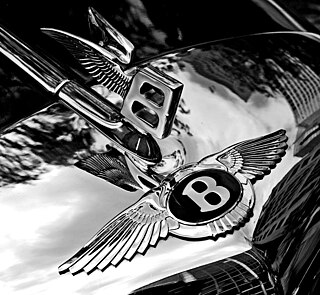
Bentley Motors Limited is a British designer, manufacturer and marketer of luxury cars and SUVs. Headquartered in Crewe, England, the company was founded by W. O. Bentley (1888–1971) in 1919 in Cricklewood, North London, and became widely known for winning the 24 Hours of Le Mans in 1924, 1927, 1928, 1929 and 1930. Bentley has been a subsidiary of the Volkswagen Group since 1998 and consolidated under VW's premium brand arm Audi since 2022.
The British Expeditionary Force (BEF) was the six-divisions the British Army sent to the Western Front during the First World War. Planning for a British Expeditionary Force began with the 1906–1912 Haldane Reforms of the British Army carried out by the Secretary of State for War Richard Haldane following the Second Boer War (1899–1902).

Field Marshal John Denton Pinkstone French, 1st Earl of Ypres,, known as Sir John French from 1901 to 1916, and as The Viscount French between 1916 and 1922, was a senior British Army officer.
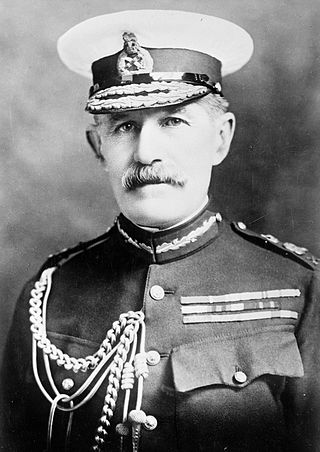
General Sir Horace Lockwood Smith-Dorrien, was a British Army General. One of the few British survivors of the Battle of Isandlwana as a young officer, he also distinguished himself in the Second Boer War.

IV Corps was a corps-sized formation of the British Army, formed in both the First World War and the Second World War. During the First World War the corps served on the Western Front throughout its existence. During the Second World War it served in Norway and Britain until it was transferred to India, which was threatened with attack after Japan entered the war.

Coupé de ville — also known as town car or sedanca de ville — is a car body style produced from 1908 to 1939 with an external or open-topped driver's position and an enclosed compartment for passengers. Although the different terms may have once had specific meanings for certain car manufacturers or countries, the terms are often used interchangeably.

The First Battle of Ypres was a battle of the First World War, fought on the Western Front around Ypres, in West Flanders, Belgium. The battle was part of the First Battle of Flanders, in which German, French, Belgian armies and the British Expeditionary Force (BEF) fought from Arras in France to Nieuwpoort (Nieuport) on the Belgian coast, from 10 October to mid-November. The battles at Ypres began at the end of the Race to the Sea, reciprocal attempts by the German and Franco-British armies to advance past the northern flank of their opponents. North of Ypres, the fighting continued in the Battle of the Yser (16–31 October), between the German 4th Army, the Belgian army and French marines.

The Battle of Mons was the first major action of the British Expeditionary Force (BEF) in the First World War. It was a subsidiary action of the Battle of the Frontiers, in which the Allies clashed with Germany on the French borders. At Mons, the British Army attempted to hold the line of the Mons–Condé Canal against the advancing German 1st Army. Although the British fought well and inflicted disproportionate casualties on the numerically superior Germans, they were eventually forced to retreat due both to the greater strength of the Germans and the sudden retreat of the French Fifth Army, which exposed the British right flank. Though initially planned as a simple tactical withdrawal and executed in good order, the British retreat from Mons lasted for two weeks and took the BEF to the outskirts of Paris before it counter-attacked in concert with the French, at the Battle of the Marne.

Walter Owen Bentley, was an English engineer who founded Bentley Motors Limited in London. He was a motorcycle and car racer as a young man. After making a name for himself as a designer of aircraft and automobile engines, Bentley established his own firm in 1919. He built the firm into one of the world's premier luxury and performance auto manufacturers, and led the marque to multiple victories at the 24 Hours of Le Mans. After selling his namesake company to Rolls-Royce Limited in 1931, he was employed as a designer for Lagonda, Aston Martin, and Armstrong Siddeley.

The Royal Automobile Club is a British private social and athletic club. It has two clubhouses: one in London at 89 Pall Mall, and the other in the countryside at Woodcote Park, near Epsom in Surrey. Both provide accommodation and a range of dining and sporting facilities. The Royal Automobile Club has a wide range of members.

The Motor Car Act 1903 was an Act of the United Kingdom Parliament that received royal assent on 14 August 1903, which introduced motor vehicle registration, driver licensing and increased the speed limit.

Lieutenant-General Sir George Montague Harper,, was a senior officer of the British Army during the First World War.
Arthur Edward George was an accomplished sportsman, an aviation pioneer, aircraft designer, racing driver, engineer and businessman. He served in the Second Boer War, in World War I and in World War II, and was awarded the Silver medal of the Royal Aero Club posthumously for his "Services to aviation over 50 years".
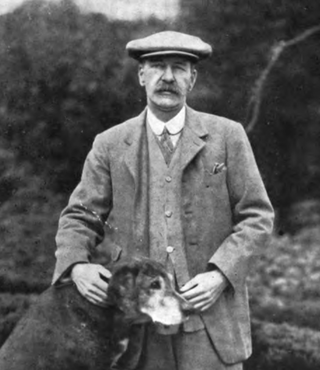
Colonel Sir Alfred "Toby" Rawlinson, 3rd Baronet, was an English soldier and intelligence officer, sportsman, pioneer motorist and aviator.

The British Army during the First World War fought the largest and most costly war in its long history. Unlike the French and German Armies, the British Army was made up exclusively of volunteers—as opposed to conscripts—at the beginning of the conflict. Furthermore, the British Army was considerably smaller than its French and German counterparts.
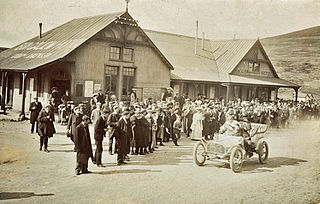
The 1905 International Tourist Trophy was an automobile motor race held on 14 September 1905 on closed public roads along the Highroads Course on the Isle of Man. It was organised by the Automobile Club of Great Britain and Ireland, and was the first time that what became known as the RAC Tourist Trophy was awarded. The race lasted over six hours and was won by John Napier, driving an Arrol-Johnston. Percy Northey finished second in a Rolls-Royce, while the Vinot-Deguingand driver Norman Littlejohn was third.
Claude Goodman Johnson was a British motor vehicle manufacturer who was instrumental in the creation of Rolls-Royce Limited.
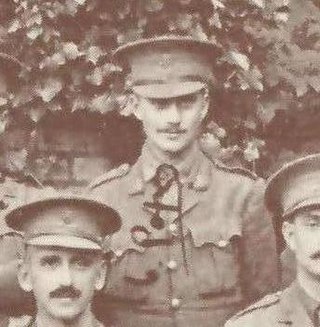
Lieutenant-General Vyvyan Vavasour Pope CBE DSO MC & Bar was a senior British Army officer who was prominent in developing ideas about the use of armour in battle in the interwar years, and who briefly commanded XXX Corps during the Second World War before dying in an air crash.
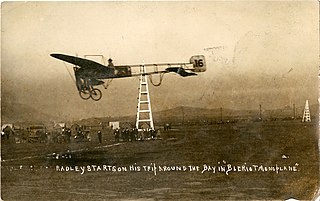
James Radley (1884–1959) was one of the first English aviators, holding Royal Aero Club Aviators Certificate Number 12. As well as carrying out demonstration flights and competitions in aircraft, he also piloted a ballon in a number of balloon races. As well as his interests in aviation he was a racing driver.
The National Association of Volunteer Motor Transport Corps, commonly known as the Swedish Voluntary Motor Transport(ation) Corps is a Swedish nationwide voluntary organization with the task of further training drivers to ensure the need for heavy vehicles and buses etc in a crisis situation.
References
- ↑ Rawlinson pp. 5-6
- ↑ Rawlinson p. 7
- 1 2 "Royal Automobile Club Volunteer Force 1914". www.westernfrontassociation.com. The Western Front Association. 22 May 2008. Retrieved 7 October 2016.
- ↑ Rawlinson p. 15
- ↑ Coleman p. 60
- ↑ Rawlinson p. 124
- ↑ Rawlinson p. 100
- ↑ Gardner p. 150
- ↑ Smithers pp. 41-43
- ↑ "MotorSport Archive - Page 26, May 1967 - Cars in books". www.motorsportmagazine.com. Motor Sport Magazine. 7 July 2014. Retrieved 8 October 2016.
- ↑ "MotorSport Archive - Page 39, April 1967 - Cars in books". www.motorsportmagazine.com. Motor Sport Magazine. 7 July 2014. Retrieved 8 October 2016.
- 1 2 Baker-Carr p. 14
- ↑ "The Flying Lady". Rolls-Royce Owners' Club. 1951: 114. Retrieved 24 February 2014.
{{cite journal}}: Cite journal requires|journal=(help) - ↑ Coleman p. 25
- ↑ Rawlinson 1925, pp. 80 and 105-106
Bibliography
- Baker-Carr, Christopher D'Arcy (1930). From Chauffeur to Brigadier. London: Ernest Benn Ltd.
- Coleman, Frederic. From Mons to Ypres with French: a personal narrative. Toronto: William Briggs.
- Gardner, Nikolas (2003). Trial by Fire: Command and the British Expeditionary Force in 1914. Praeger. ISBN 978-0313324734.
- Messenger, Charles (2005). Call to Arms: The British Army 1914-18. Weidenfeld & Nicolson. ISBN 978-1-7802-2759-7.
- Rawlinson, Alfred (1925). Adventures on the Western Front: August, 1914 - June, 1915. London: Andrew Melrose Ltd.
- Smithers, A J (1992). Cambrai: The First Great Tank Battle. Pen & Sword Books Ltd. ISBN 978-0850522686.